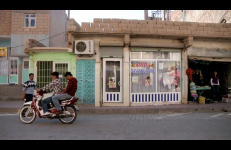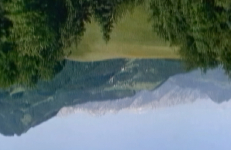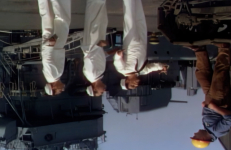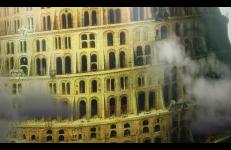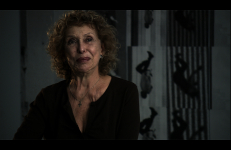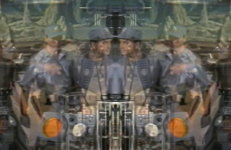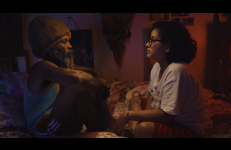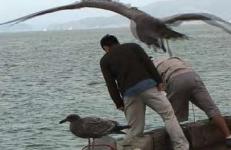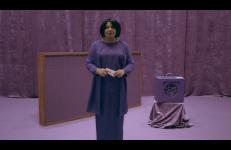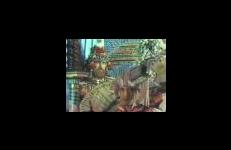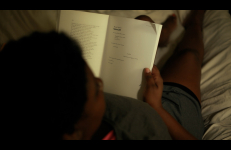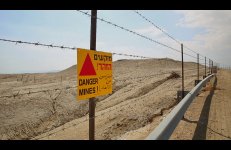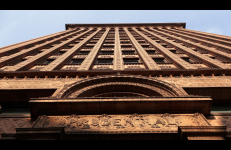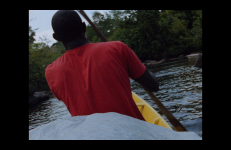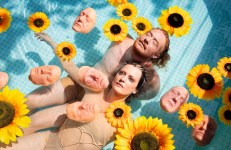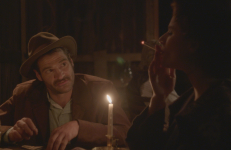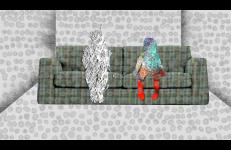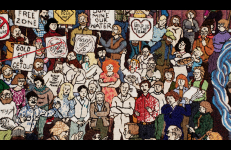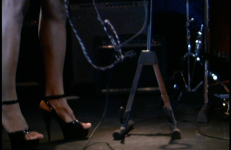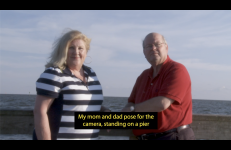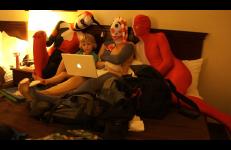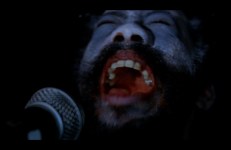1+8 is a film about Turkey’s unique position between West and East and her relationship to her eight very distinct and diverse neighbors. 1+8 is filmed close up on border towns of Turkey with Greece, Bulgaria, Georgia, Armenia, Nakhchivan/Azerbaijan, Iran, Iraq and Syria exploring what connects and separates the people on both sides. The film showcases through intimate portraits, personal accounts and cinematographic tropes, Turkey’s eight borderlands revealing the political and cultural dynamics of life on those frontiers.
Feature Length
This film is an appropriation from the 1965 movie The Sound of Music. Each sync sound frame of the Prelude and opening song "The Hills are Alive" is repeated 16 times and reorientated.
This film is an appropriation from the 1949 movie On the Town. Each sync sound frame of the Overture, "I Feel Like I’m not of Bed Yet" and "New York New York" is repeated 32 times and reoriented.
Babeldom is a city so massive and growing at such a speed that soon, it is said, light itself will not escape its gravitational pull. How can two lovers communicate, one from inside the city and one outside? This is an elegy to urban life, against the backdrop of a city of the future, a portrait assembled from film shot in modern cities all around the world and collected from the most recent research in science, technology and architecture.
"It’s a complex architectural vision equal parts awesome and terrifying… This is a film – and city – to get lost in."
Marielle Nitoslawska’s Breaking the Frame is a feature–length profile of the radical New York artist Carolee Schneemann. A pioneer of performance art and avant-garde cinema, Schneemann has been breaking the frames of the art world for five decades by challenging the taboos leveled against the female body. Breaking the Frame is a kinetic, hyper-cinematic intervention, a critical medita-tion on the intimate correlations animating art and life.
Praise for Breaking the Frame:
Stephen Varble (1946-1984) staged gender-confounding costume performances on the streets of 1970s Manhattan, and he became infamous for his anti-commercial disruptions of galleries, banks, and boutiques. In 1978, he retreated from this public work to focus on the making of an epic, unfinished piece of video art, Journey to the Sun, until his death in the first days of 1984. Lush, ribald, and unorthodox, the video mixed non-narrative costume performances with a surrealist fable of a messianic martyr, the Warbler.
Doubling Forbidden Planet is a feature length reedit of the 1956 science fiction film Forbidden Planet. This re-edit was produced in 2003 using a DIY apparatus of sequenced analog security system switchers, circuits and VHS players captured into a computer. The semi rhythmic and overlapping cuts produced by the switchers generated fragmented movement, dialogue, and soundtrack. Forbidden Planet’s soundtrack was made by Bebe and Louise Baron.
Three aimless millennials in a go-nowhere band are recruited as willing pawns by a shadow revolution, an insurrection led by an unlikely anti-government cabal of Buddhist sovereign citizens, telepathic Native American separatists, hardline Rastafas spearheaded by the dreadlocked King Alpha, and AR-toting doomsday preppers. Their mission: to find and execute [names redacted].
Three aimless millennials in a go-nowhere band are recruited as willing pawns by a shadow revolution, an insurrection led by an unlikely anti-government cabal of Buddhist sovereign citizens, telepathic Native American separatists, hardline Rastafas spearheaded by the dreadlocked King Alpha, and AR-toting doomsday preppers. Their mission: to find and execute [names redacted].
Endless Dreams and Water Between is a feature film with four fictitious characters sustaining an epistolary exchange in which their “planetary thought” is woven with the physical locations they inhabit, visual and aural characters in themselves: the island of Manhattan, the island of Majorca, in Spain, and the islands and peninsula that form the San Francisco Bay Area. The characters’ reflections and dreams enact what could be described as “an archipelagic mind,” linking worlds, time, and space.
Incense Sweaters & Ice is a new feature film inspired by the idea that anything one does while being watched is a performance. The film follows three protagonists — Mrs. Queen Esther Bernetta White, Girl, and WB (“whiteboy”) — as they navigate the dramas of surveillance, moving between looking, being looked at, and remaining unseen. How does the ever-present potential image affect the way we act and the way we see ourselves? By examining how cinema now happens in real time, Syms works between the documented and the live to find the lie.
Stephen Varble began Journey to the Sun as a series of performances with projected slides in 1978. After becoming notorious for unauthorized costume performances on Soho streets in the mid 1970s, Varble receded from his public persona at this time. Deriving from his identification with his idol, the reclusive actress Greta Garbo, and informed by the spiritual practice of Subud, Varble began writing an allegorical epic about a musician, the Grey Crowned Warbler, who undergoes tribulation and metamorphosis on a journey to transcendence.
Rosie Cutler, a middle school lunch lady, and TJ Fortune, a outcast student, have an unusual relationship. Mystically-minded and gender ambiguous, TJ recoils into an abandoned warehouse where he builds a massive sculptural shrine from discarded objects and trash. Through a dream Rosie makes intimate contact with a trans-worldly being who she hopes will bridge the gap between real and imagined to reveal truths about our world.
A series of unnatural deaths and departures (almost all, of men) disrupts the lives of nine families sharing an apartment building in Jerusalem.
Buffalo, New York, which was once a prosperous city, is home to several architectural masterpieces built in the late 19th century to the early 20th century, such as the Darwin D. Martin House by Frank Lloyd Wright, the Guaranty Building by Louis Sullivan, and Kleinhans Music Hall by Eliel and Eero Saarinen. While some important buildings, including the Larkin Building by Wright, were demolished, the preservation movement has been active for the past several years. Architecture is embraced as a treasure, but it can be a burden to the city at the same time.
"Let Each One Go Where He May is the stunning feature debut of celebrated Chicago-based filmmaker Ben Russell. Having its world premiere in Toronto, the film traces the extensive journey of two unidentified brothers who venture from the outskirts of Paramaribo, Suriname, on land and through rapids, past a Maroon village on the Upper Suriname River, tracing the voyage undertaken by their ancestors, who escaped from slavery at the hands of the Dutch 300 years prior.
Magic Thinking is a multi-platform film installation steeped in the current moment when climate catastrophe, the COVID pandemic, and the rise of fundamentalism combine to contribute to an apocalyptic aura. With this aura, magical thinking can become a survival strategy, creating surprising bedfellows. In particular, the confluence of far-right extremism and the “wellness” world.
Blending live action staged as if in a dollhouse with rarely seen archival footage from the National Archives, the fantastically true story of how America entered WWI is told. Through vibrant historical characters like labor leader Elizabeth Gurley Flynn and German naval officer Franz von Rintelen this loose adaptation of John dos Passos’ 42nd Parallel, explores the timeless issues of radical labor politics and the domestic effects of war.
The Night Visitors is a movie about moths. In large and small fragments, looking both inward and out, through a critical lens that is by turns social and personal, the film closely examines these under-known creatures. While The Night Visitors is interested in moths as organisms, with fascinating life histories, staggering biodiversity, and a functional importance as indicators of climate change and habitat degradation, its engagement with them is not primarily entomological.
Paternal Rites is a first-person essay film that examines the secret underbelly of a contemporary Jewish American family as they grapple with the aftereffects of physical and sexual abuse on their present-day lives. It is also a groundbreaking film about the nature of trauma and memory itself: the ways in which trauma encrypts in uncanny ways; the function of speech and narrative in the process of decryption; and the role of film and filmmaking in the practice of healing.
In the face of environmental threats, a radical back-to-the-land community in the Sierra Foothills races to collectively stitch its 50 years of innovative sustainability into an epic 83-foot tapestry, one tiny stitch at a time. San Juan Ridge, an alternative collective of artists and ecologists in the Sierra Foothills, saved the Yuba River from being dammed while surviving numerous challenges like mining, logging, and climate change-created drought and wildfires. Bay Area media artist Jeanne C.
Representing the complex lives of transgender and gender variant musicians in the US and Canada, Riot Acts offers a first-hand perspective of the intersections between gender performance and stage performance. The featured performers are talented, inspiring, sexy, critical and three-dimensional in a manner that purposefully counters mainstream media. Discussions range from songwriting, performance, voice presentation and voice changes, passing/not passing, audience, to the idea of the spectacle, drag, and media representation - the personal is always political.
Shared Resources depicts the filmmaker’s family after their father was fired from his job as a debt collector and their parents declared bankruptcy, largely due to the filmmaker’s own debt. Following their parents’ day-to-day lives and father’s progressing disability, the film uses open captions and visual descriptions to provide access to Blind and Deaf audiences and to reflect how their family sees themselves in the film.
The sale of a plot of land marks the kickoff of an unlikely road trip in this strange American odyssey. When eteam buys an acre of the Southwestern desert on eBay, the deed fails to arrive and the pair attempt to track down the phantom seller. Children in tow, the artists embark on a noir-inspired search through Colorado, Arizona and the American West to locate the shadowy landowner and claim their portion of the vast desert.
The close collaboration between internationally celebrated artist-filmmakers Ben Rivers (Two Years at Sea) and Ben Russell (Let Each One Go Where He May) has yielded an intriguing ethno-trance aesthetic that finds its stunning summa in their much anticipated co-directed feature A Spell to Ward Off the Darkness. An immersive, at times mesmerizing experience, Spell follows a nameless protagonist — played with Bressonian restraint by musician Robert A.A.




